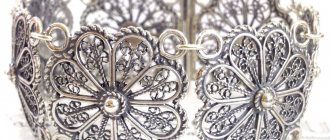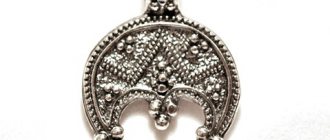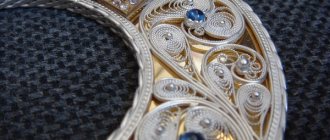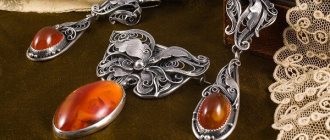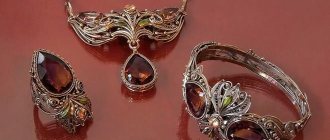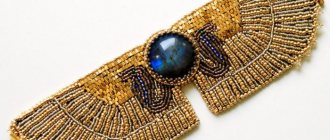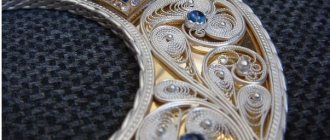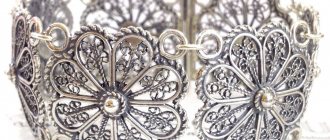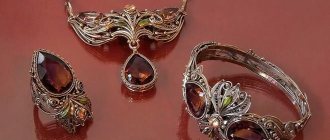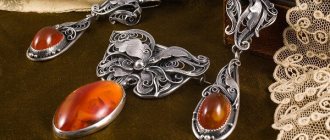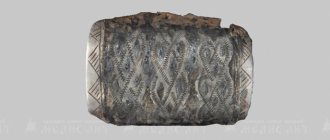Filigree (in Russian - scan , English filigree) is an openwork or wire pattern soldered to metal. And at the same time - a spoon and a glass holder in the buffet of many respectable families. The word “filigree” shows the essence of production: the Latin filum - “thread” and granum - “grain”, and the Russian “filigree” - from the Old Russian “skat” (to twist, twist). Most often, filigree is made of silver, but filigree patterns are also made of gold and other metals. Silver and gold are very soft and can be easily pulled out into very thin wires. The wire for the filigree pattern (silver, less often gold) can be smooth or twisted into ropes and spirals. Filigree was known throughout the ancient world (Crete, Egypt, Troy, Greece VI-IV centuries BC). This is one of the basic, “original” jewelry techniques.
Types of jewelry filigree
Filigree can be soldered, openwork and voluminous. In brazed filigree, wires and grains are soldered directly onto sheet metal. If the background is left, it is background or “blank” filigree. When, after soldering, the background is removed (by notching or sawing), then this is notched or sawn filigree. In embossed relief filigree, the pattern is soldered onto the embossed relief. In openwork filigree there is no metal base: the wire pattern is soldered on itself, and the grain is attached directly to the metal lace. If the “lace” is flat, then it is flat openwork filigree. If the lace is soldered in two dimensions and is voluminous (three-dimensional relief or high relief), then it is sculptural-relief openwork filigree.
“Russian filigree” in foreign sources . Volumetric filigree - cups, vases, trays, caskets and buildings, and even creatures - birds, animals. It is created in parts and then assembled into a single composition. In jewelry they use both flat (frame pendants), and openwork-volume (hemispherical complex brooches and rings, link and “solid” bracelets), and sculptural (animals, birds, bells) openwork filigree made of silver and other metals.
Jewelry technicians
At all times, jewelry has been a luxury item. One of the first metals discovered by man was gold. It attracted the attention of ancient people with its bright yellow color and ease of processing. The masters of Ancient Egypt, using primitive tools, created real works of art from this precious metal.
The achievements of modern science and the development of jewelry technology today make it possible to improve the natural appearance of precious and semi-precious stones. Special processing processes can give stones the desired color, clarity, strength, as well as increase their value and make them suitable for further use in jewelry.
Currently, there are many types of jewelry techniques that are widely used for making and decorating products. The most common technique used in almost all jewelry industry enterprises is stamping, which creates products of complex shapes.
Precision casting techniques are used to produce both voluminous and lightweight jewelry, which have gained particular popularity these days. Diamond milling is used to decorate jewelry, with the help of which various ornamental compositions are created.
Only a highly qualified master jeweler with creative imagination can truly highlight the beauty and attractiveness of a stone.
The main methods of processing precious stones are cutting and polishing. Thanks to cutting, the stone receives a certain shape and begins to glow with new bright and pure colors. As a result of polishing, gems acquire a smooth surface and a mirror-like shine, and the clarity of their natural pattern is enhanced.
Unique technologies and modern equipment allow us to work with any type of precious stones, while creating high-quality jewelry of a high level.
On our website www.jevel.ru you can find all the information you are interested in about jewelry, learn about the materials and tools used in their manufacture. The site provides a detailed description of all technological processes, new jewelry techniques used in creating jewelry. By looking at the jewelry social network, you will get acquainted with interesting facts regarding jewelry art, learn how a piece of jewelry is born, and how you can create it yourself with the help of simple devices.
Who owns the filigree technique?
It would be a mistake to consider that filigree is a purely Russian craft. The traditions of filigree art are alive in modern schools in different countries. The filigree of Armenia is subtlety and flatness, of Dagestan - an abundance of grains and hemispheres, of Kostroma - complex volumetric shapes. Products using the filigree technique are produced by jewelers from various countries - France, Italy... Painfully familiar silver openwork patterns can unexpectedly be found in jewelry, for example, from Ecuador. And you shouldn’t be surprised by this, because it is in Latin America that ancient “silver” crafts, including filigree, are especially alive.
Examples of Ecuadorian filigree jewelry:
How is filigree jewelry made?
Elements of a filigree pattern are rope, cord, weaving, herringbone, track, satin stitch, and so on. It is essentially a lace appliqué made from metallic thread. Filigree is often combined with granulation - small balls that are soldered into prepared cells (recesses). The grain gives filigree a particularly elegant, sophisticated look. The materials for the products are alloys of gold, silver and platinum, as well as copper, brass, cupronickel, and nickel silver. The filigree technique can be used to make all types of jewelry without exception.
Silver filigree and more - manufacturing technology
A master scanner (who worked in royal or monastic workshops) worked along the entire “chain” of the process, from conception to completion of the product.
In modern jewelry production, of course, division of labor has long been used, but the technology for creating filigree jewelry itself has changed little. What does filigree production technology look like? In general, to “type a filigree”, you first need to bend the details of the design, and then install, adjust, and glue them in place. It is more convenient to prepare all the elements of the design, and only then secure them in place. Elements of the filigree pattern are bent using tweezers - forceps. Its ends are pointed and capture the thinnest “scans”. The curved parts of the future scan are laid out on paper with a pattern already applied and the set is carried out in the same way as on sheet metal (in the case of a background scan). The density of the set is “extremely important” - the “curls” are soldered only to each other, the background is “no help” for them. If the set is loose, the openwork filigree “crumbles,” which means secondary insertion and soldering. When soldering, the paper with the pattern applied burns, and the curls are soldered together, forming a durable patterned lace. The final stage of filigree manufacturing technology includes silver plating of the product with 999.9 anode silver. Aging is carried out by oxidation.
How was the filigree “tempered”? The history of the heyday of filigree
In the 17th century, the demand for filigree jewelry grew. In the 18th century, serious filigree items were created; along with stones, crystal and mother-of-pearl were used. Little joys are not forgotten either - vases, salt shakers, boxes. Since the nineteenth century, filigree has become a manufactured product. The technology is being honed, relief openwork filigree is blooming, and translucent stained glass is appearing - openwork filigree with transparent enamel. Having experienced decline at the beginning of the twentieth century, filigree jewelry techniques have regained strength since the middle of the century. In 1937, the works of craftsmen from the village of Krasnoe-on-Volga ( "Krasnoselsky Handicraftsman" , near Kostroma) were shown at the World Exhibition in Paris, where they took gold for filigree brooches, boxes and other accessories, and in 1939 - in New York . They also took up filigree in the village of Kazachkovo (Vachsky district of the Nizhny Novgorod region).
Kazakovskaya filigree – modern production
Today, the Kazakovsky Art Products Enterprise (KPHI) is a serious “filigree” brand (website kphi.rf), specializing specifically in products using this technique. KPHI brand jewelry is usually made of silver-plated alloy.
What distinguishes Kazakovskaya filigree? When composing a pattern, the master monitors the harmony of its individual parts, the beauty of the lines of large and small elements. The artist also works on the design of the gaps: this is extremely important in constructing the pattern. The charm of Cossack products lies in their openwork - filigree as an end in itself. The KPHI website has spread a filigree web of powerful temptation.
Lures are varied: filigree dishes - for reasonable housewives; for hipsters - filigree flash drives; to the ruling authorities - kits for the consumption of alcohol and tobacco. Women's jewelry is not forgotten either - it is spectacular and elegant at the same time. “Slavyanka” jewelry combines fidelity to style with originality and purity of finish. The lack of inserts softens the price.
Examples of products from Kazakovskaya filigree (KPHI):
Filigree from "Kubachi"
Kubachi jewelers (kubachi.su), along with the traditionally famous Dagestan technique of blackening, chasing and engraving, also produce filigree items of incredible beauty.
Examples of filigree work by Kubachi jewelers:
Filigree. Features and meaning of filigree technique
Features of filigree
Filigree is not complete without thin wire. It is twisted into openwork patterns or soldered onto a metal base. The name of the technique is taken from the Greek language.
In it, the word “filigree” means “twist”, “knot”. In Rus', this meaning was put into the verb “skat”. Therefore, in the domestic space, filigree is still called “filigree”.
The meaning of the filigree technique is to create a structure out of metal that resembles lace. It is not possible to imitate airy fabric using thick wire. The base for filigree, most often, does not exceed 1.5 millimeters in diameter.
Jewelry techniques are divided depending on the shape of the metal thread. Round wire is not always used. Sometimes it is deformed and flattened into a ribbon.
Filigree designs are laid out either with a single thread or with cords formed from several wires. Metal spheres often add volume to compositions.
They are attached using solder to the outside of the products. The first example of such work is jewelry found by archaeologists in Egypt. The items date back to the second millennium BC.
Metal balls soldered onto twisted wire are called grains. Hence the name for filigree using spheres – granulation. This technique prevailed until the early Middle Ages.
From the 13th century, goldsmiths began to emphasize filigree made only from wire. Silver and gold threads are considered classic options. Other metals are rarely used.
The Filigree technique is not subject to machines. It is done only manually. Even copper products are expensive. Customers of exclusive items are willing to pay extra for precious raw materials.
The raw materials for filigree are 100% precious Only pure metals are used, without impurities. Additives make gold and silver less ductile, which is unacceptable for filigree.
To recreate the smallest “knitting”, the most pliable wire is needed. In ready-made samples, this quality of the material ceases to be a plus.
Filigree is easy to damage and make a dent on the product. In this regard, craftsmen often place a base - metal sheets - under the openwork surface. They make jewelers' creations durable.
Classic filigree is a team effort. Several craftsmen work on the products. A dedicated specialist is assigned to each stage of the work: preparing the template, twisting the metal thread, folding it into patterns, soldering them, mounting and decorating the surface of the object.
The sketch should show the product on a plane. The pattern is divided into parts depending on the filigree technique used in different elements of the composition.
Often, parts from different types of wire are combined in one item. For example, both thin and thick threads are used in boxes; flat and round wires; twisted and smooth blanks.
Thread twisting is partly automated. The wire is twisted using an electric motor, or more precisely, its spindle. Some craftsmen also use drills.
Rollers are also used to form blanks. In them the wire is flattened. Twisting threads into cords and laying them out according to the intended pattern is only possible by hand. This also applies to decorating products.
There are exceptions when the filigree is not made of wire. Thus, in the 15th and 16th centuries, craftsmen mastered the technique of openwork processing of wood and ivory. Many cavities were cut out in them.
The voids gave the products airiness and the texture of lace. Some modern craftsmen also make filigree ivory samples. The bone in their products is not real. Elephant hunting is prohibited. Designers use adhesive mass. As it hardens, it skillfully imitates natural material.
Paper filigree
The non-jewelry industry also includes paper filigree. This type of technique is called quilling. To “knit” patterns, designers use sheets of metal.
They are cut into strips 3-6 millimeters wide and 40-60 centimeters long. The blanks are twisted in a spiral. They are deformed, giving the workpieces different shapes. The resulting ovals, circles, squares, etc., are laid out by craftsmen in compositions.
Jute filigree
Metal is also replaced with vegetable cord. The technique is called " jute filigree ". The name comes from the name of the plant from which the threads are obtained.
Jute belongs to the linden family. The fibers of the bush are coarse and grayish-brown. They are not soldered, but, like paper samples, glued together. Jute threads are used to make two main elements – loops and curls. All patterns developed by artists consist of them.
Jute, paper, metal... any filigree can be flat or voluminous. The “knitting” technique is used to make vases, caskets, and dishes. Flat filigree is useful in paintings, jewelry, and interior decorative elements.
By the type of products, you can often determine where they come from. In Dagestan they specialize in products made from hemispheres, richly decorated with grains.
In Armenia, on the contrary, they teach how to create planar filigree from thin threads, without adding spheres. In Russia, Kostroma is considered the center of filigree. Samples of complex shapes are made there. All creations of Kostroma masters are three-dimensional, consisting of elements of different shapes and sizes.
The painstaking work of creating filigree has been compared to the task of shoeing a flea. It’s not for nothing that there is a characteristic “filigree work”. This is what they say about works that stand out from the general background, performed skillfully.
So, filigree is not complete without thin wire. Its existence is impossible without the talent of the master.
Where can you buy real filigree jewelry?
Unfortunately, finding true filigree is not so easy. Not all jewelry enterprises (and KPHI is a typical example) disclose on their websites the names of retail chains with which they cooperate to sell products. As a result, you can completely accidentally “come across” scanned items by simply going to a regular jewelry store near your home - with the same success as not finding it at all, having walked around a dozen stores.
One of the more reliable ways today is to attend jewelry exhibitions, which are regularly held in Moscow and other large cities (jewelry exhibition calendars). More or less serious jewelry companies from different parts of the country are represented there, making jewelry using a wide variety of techniques. And you can even meet those manufacturers who do not sell through stores at all, whose assortment can be seen exclusively at exhibitions.
If you wish, you can also try searching for filigree products made in different countries (including eastern ones - Nepal, Thailand) in online stores, as well as on the websites of private jewelers, websites for collectors, or foreign stores or hand-made resources like etsy.com. On the latter you can find beautiful antique specimens.
As we find manufacturers and retailers offering real filigree, we will add them to our Manufacturer Directory and Seller Directory, where you can find them by specifying your search parameters.
Products with “filigree elements” versus “true filigree”
Jewelry almost always contains filigree elements: a scattering of beads of grain, a cord or rope of metal around an insert with a stone or pearl. Sometimes filigree curls and grains are soldered onto cast or stamped parts of the jewelry. On the one hand, this is no longer completely filigree and not purely handmade. But such “combi-filigree” is often stronger, cheaper and more accessible than its noble “cousin” - pure hand-made filigree.
The balance of aesthetics and practicality will give the buyer the desired vector. Let's say the strength of the earlobe is not limitless. And your goal is voluminous earrings or a pendant. In openwork hand-made filigree, the ratio of dimensions to weight is the most humane, perhaps this is “to your advantage” (to your ears). Bracelets and rings may require greater strength, and then “mixed” filigree will seem “stronger” than filigree. The main thing, as always, is to understand the difference between true filigree and its imitation, consciously giving money for this or that product.
For comparison: on the left is a ring with “filigree elements”, on the right is a filigree bracelet
The work of a jeweler
There was no floor beyond the threshold on which one could place one's foot, and for several moments the Archmage simply fell, but then he called on a powerful levitation spell, in which he was helped by a brooch with the emblem of the House of Baenre (he never parted with this brooch) .
And you shouldn’t have demanded your sparkling crescent-moon brooch from your grandmother, let your grandmother vilify it, and the neighbor’s children might take it away from Milka, who saw how she dug this brooch out of the ground... “For now, wear this broken plastic brooch, no one will take it away for sure.” ...You gave it to your friend?!
It was a silver brooch, too expensive a gift for Polly's income, and Mrs. Meeker quickly calculated that this could keep the electric company quiet for about a month without Polly even knowing where the brooch had gone.
The second brooch holds them together, after which they separate, hugging her entire body, meeting again on her back, where the third brooch is, and returning to intertwine on her stomach.
His wife often wore it... And Miss Miller, accepting the brooch, replied, as if in pre-prepared words, that now it would be her most precious possession... Hopefully, he thought, she has some kind of dress that won’t have a pearl brooch on it look so ridiculous.
This morning, the jeweler Monsieur Jacques Falbaron provided us with information that you called him and offered to buy a brooch, which he immediately recognized from your description as the missing Lirac brooch.
It is preferable for young women to wear a brooch in the shape of a “twig”; for respectable ladies, a brooch in the shape of a “leaf” is suitable.
Their decision was not influenced in any way by the testimony of Helen's maid, who stated that the brooch found in Slater's apartment was not the one stolen from her deceased mistress, nor by the indisputable fact that this brooch was pawned not after, but before the murder of the old woman. lady…
In some book he read about a thief: he lived quietly, back in Soviet times, he kept the guys on the “piece of iron” near the jewelry purchase, and one of those boys of his bargained with an old woman for a brooch for four hundred rubles in the money of that time, consider it as one red frame; Neither the old woman knew the price, nor this goofy boy, but in that brooch there was a stone, a diamond the size of a pigeon’s egg for an immeasurable price!
Moreover, this swindler managed to contact Vishtalyuk herself - a brooch was allegedly stolen for her, with which the thief was caught. – Morozov was silent. – If he doesn’t come to today’s meeting... If he doesn’t come to an agreement with Nina Vishtalyuk about selling the brooch... You understand.
How to wear filigree jewelry: our recommendations
Wearing filigree requires an approach: its “lace” requires a contrasting background, stylistic unity with clothing. Light filigree looks luxurious on dark skin, looks clear against the background of dark hair, and goes well with a dark manicure. Blackened filigree is especially effective on pale skin, or with pastel-colored clothing. In a word, any contrast - color, graphic or texture (we mean smooth fabrics: satin, satin, etc.) will “reveal” a filigree product. And if everything is taken into account, then know: wearing filigree, you will not get lost in the crowd.
JEWELRY MAKING | Jewelry techniques - types Jewelry with enamel | Hot and cold enamel technique | Cloisonné technique | Georgian cloisonne enamel | Rostov enamel
Metal chasing. Metal engraving technique. Embossing on metal Blackening of gold and silver. Northern blackening plant - blackening classics | Metal etching. Chemical gilding. Silvering of jewelry. Oxidation, and other coatings | Chainmail weaving and its types
Share this article with your friends
Works by designers from the JEWELIRUM catalog
- Co.Cos Jewelry
- Co.Cos Jewelry
- Taiga Jewelry, Tomsk
- Taiga Jewelry, Tomsk
- Ilya Maksimov, Crimea
- Ilya Maksimov, Crimea
- UBIRING
- UBIRING
- Diamonds are Forever
- Diamonds are Forever
- Rings in natural style, Sergacheva Jewelery
- Earrings with pearls, Sergacheva Jewelery
- Cabochon ring, Minty Sky
- Fly earrings, Minty Sky
- Ring, Precious Park
- Ring, Precious Park
- Snake skin ring, Stoyanova Jewelery
- Chain earrings, Stoyanova Jewelery
- Children's pendant - stick, Matthew&Daniel
- Pendant for a child, Matthew&Daniel
- Bracelet, Svetlana Subbotina
- Ring with Slavic symbols, Svetlana Subbotina
- Indian style ring, Anna Goffman
- Indian style ring, Anna Goffman
- Earrings, ISTA
- Geometric ring, ISTA
- Earrings with enamel, PNJewelry
- Ring with enamel, PNJewelry
- Ring, Khramtsova Jewelry
- Ring, Khramtsova Jewelry
- Wedding rings to order, obruchalki.com
- Wedding rings to order, obruchalki.com
- Earrings, Yuri Bylkov
- Earrings, Yuri Bylkov
- Titanium bracelets, LanaMuransky
- Titanium pendant, LanaMuransky
- Brooch Elephant (after Salvador Dali), THING
- Ring Veil, THING
- Mace earrings, VLADIMIR MARKIN
- Cufflinks, jewelry mechanics, VLADIMIR MARKIN
- Drop-shaped ring, EKATERINA TOLSTAYA
- Drop-shaped earrings, EKATERINA TOLSTAYA
- Necklace with amber, LETA
- Earrings with amber, LETA
- Children's earrings, combinable, FASHBY
- Children's earrings, combinable, FASHBY
- Ring of architectural form, Elizaveta Malafeevskaya MANU_L
- Architectural bracelet, Elizaveta Malafeevskaya MANU_L
- Set Ginkgo Leaf, SHABUT JEWELLERY
- Brooch Wearable porcelain, SHABUT JEWELLERY
- Architectural ring, GEOMETRY
- Brooch, porcelain, GEOMETRY
- Necklace made of polymer clay, LICORNE ART
- Brooch made of polymer clay, LICORNE ART
- Ring, avant-garde, VALERY SEREDIN
- Bracelet, avant-garde. VALERY SEREDIN
- Wooden set, Scandinavian/Japanese minimalism, VLADIMIR SHESTAKOV
- Ring, Scandinavian/Japanese minimalism, VLADIMIR SHESTAKOV
- Earrings, TON ANT
- Ring, TON ANT
- Architectural ring, ANCHOR
- Architectural necklace, ANCHOR
- Earrings, GOHFELD JEWELLERY
- Necklace, GOHFELD JEWELLERY
- Massive ring, YAKISCHIK
- Designer jewelry, YAKISCHIK
- Architectural ring, ONE DAY ART
- Architectural ring, ONE DAY ART
- Brooch, bionics, VALERIYA MARKOVA (TESSA)
- Unclosed ring, bionics, VALERIYA MARKOVA (TESSA)
- Ring, bionics, BEAVERS
- Earrings, bionics, BEAVERS
- Earrings, asymmetry, VAGANOVA JEWELRY
- Airplane ring, VAGANOVA JEWELRY
- Flower ring, ALCHEMIA JEWELLERY
- Set, ALCHEMIA JEWELLERY
- Pendant-cat, ethnic, STUDIO OF ILYA AND VERA PALKIN
- Earrings, STUDIO OF ILYA AND VERA PALKIN
Comments
- Natalia
help me find a jeweler who works in filigree technique. I want to order a bracelet in the style of ancient oriental filigree. Thank you
7 years ago Reply
- juvelirum
Natalya, good afternoon! Unfortunately, we personally don’t know any jewelers who specialize in filigree or filigree. Try asking a question on jewelry forums or go to the nearest jewelry exhibition, where there are usually many craftsmen (exhibition schedule:)
7 years ago Reply
- Emma
in the Altai Republic, Ongudai district from Kupchegen, there is a workshop there that makes a lot of beautiful handicrafts from leather, iron, wool, felt, including filigree.
6 years ago Reply
- Ilyas
I am a jeweler artist, write to me.
5 years ago Reply
I make jewelry using the filigani technique, I have experience, +79821025673
5 years ago Reply
